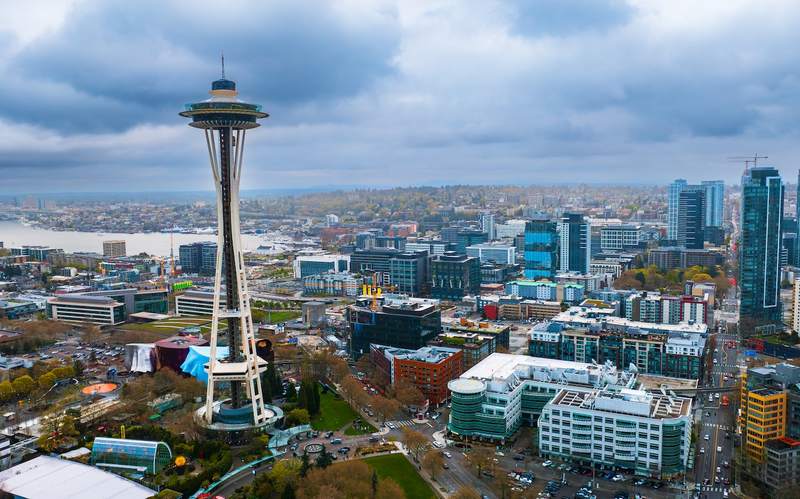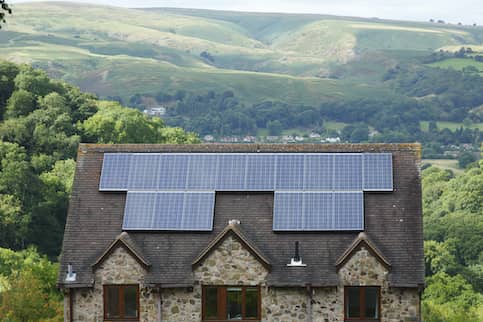The effects of climate change are all around us and have become a major factor in where people are looking to buy a home. From an increased frequency of natural disasters to extreme temperature changes, 34 states in the United States have submitted a climate action plan or are in the process of developing one to combat these effects.
However, climate change doesn’t affect every location where you’re thinking of buying a home in the same way. To understand which cities are in the best position to mitigate its effects, Quicken Loans has reviewed the data to list the 12 best places to live with climate change.
We analyzed data from the Federal Reserve’s house price index per state in Q2 2024, Best Place’s comfort index, ClimateCheck’s climate change risks, federal and state climate action plans, the Environmental Protection Agency’s cumulative resistance screening index, the Federal Emergency Management Agency’s social vulnerability index, and National Centers for Environmental Information’s climate change extreme index to gather our estimates on the best places to live if you’re concerned about the effects of climate change.
A city’s overall score is best when it is lowest, and the No. 1 best city to live in with climate change has a top score of 24.9


1. Seattle
- Population: 734,603
- Housing Price Index: 1,010
- Climate Change Risk: 40
- Climate Change Extreme Index: 16.5%
- Climate Action Plan Status: PCAP Submitted, CAP
- Cumulative Resilience Screening Index: 15.4
- Social Vulnerability Index: 37
- Comfort Index: 7.5
- Overall Score: 24.9
Seattle generally exemplifies Pacific Northwest cities for scoring well as the top place to live with climate change. Seattle benefits from relatively low heat, drought and flood risk scores, reducing the need to buy flood insurance. Even better, it has one of the lowest fire risk scores. The level of risk posed to vulnerable social groups also is comparatively low in Seattle. It also shows another common thread, which is high housing prices. Washington has the highest house price index at 1,010.


2. Portland, Oregon
- Population: 646,101
- Housing Price Index: 839
- Climate Change Risk: 39
- Climate Change Extreme Index: 16.5%
- Climate Action Plan Status: PCAP Submitted, CAP
- Cumulative Resilience Screening Index: 15.4
- Social Vulnerability Index: 58
- Comfort Index: 7.5
- Overall Score: 25.4
The City of Roses shares many of Seattle’s positive traits. Excellent climate risk scores across the board make Portland one of the best places to live in with climate change. Oregon has a state climate action plan in place, and it’s been only four years since the state issued its last one. Like Seattle, Portland benefits from lower risks of drought, fire or heat due to climate change, potentially saving you money on hazard insurance. However, the precipitation risk score for Portland is the highest in the study.
What’s Your Goal?
Buy A Home
Discover mortgage options that fit your unique financial needs.

Refinance
Refinance your mortgage to have more money for what matters.
Tap Into Equity
Use your home’s equity and unlock cash to achieve your goals.


3. Spokane, Washington
- Population: 227,922
- Housing Price Index: 1,010
- Climate Change Risk: 34
- Climate Change Extreme Index: 16.5%
- Climate Action Plan Status: PCAP Submitted, CAP
- Cumulative Resilience Screening Index: 15.4
- Social Vulnerability Index: 52
- Comfort Index: 6.7
- Overall Score: 26.9
The No. 3 best city to live in with climate change is Spokane in eastern Washington. Its inland location provides an average climate change risk score of 34, one of the lowest and best. The risk of drought and heat due to climate change is low.
Ready To Become A Homeowner?
Get matched with a lender that can help you find the right mortgage.


4. Boise, Idaho
- Population: 234,192
- Housing Price Index: 777
- Climate Change Risk: 47
- Climate Change Extreme Index: 16.5%
- Climate Action Plan Status: PCAP Submitted, no CAP
- Cumulative Resilience Screening Index: 15.4
- Social Vulnerability Index: 10
- Comfort Index: 7.3
- Overall Score: 27.9
Boise became a hotspot after the pandemic, drawing remote workers to its idyllic setting. While the state has no climate action plan, Boise is well-suited to withstand many of the effects of climate change. Boise has the lowest social vulnerability due to climate change of any city in this study.
Take The First Step To Buying A Home
Find a lender that will work with your unique financial situation.


5. San Francisco
- Population: 851,036
- Housing Price Index: 959
- Climate Change Risk: 28
- Climate Change Extreme Index: 20.6%
- Climate Action Plan Status: PCAP Submitted, CAP
- Cumulative Resilience Screening Index: 5.5
- Social Vulnerability Index: 43
- Comfort Index: 8.5
- Overall Score: 40.9
San Francisco is the fifth best city to live in with climate change. Unfortunately, it’s also one of the most expensive housing markets in the U.S. But in terms of vulnerability to climate change, it’s got a lot going for it. San Francisco’s flood risk score, fire risk score, and, most of all, its heat risk score are all very low. With a comfort index of 8.5, San Francisco is one of the best places to live with climate change.


6. San Jose, California
- Population: 1,001,176
- Housing Price Index: 959
- Climate Change Risk: 36
- Climate Change Extreme Index: 20.6%
- Climate Action Plan Status: PCAP Submitted, CAP
- Cumulative Resilience Screening Index: 5.5
- Social Vulnerability Index: 37
- Comfort Index: 8.8
- Overall Score: 42.9
Moving to the heart of Silicon Valley, San Jose is the No. 6 best place to live in with climate change. Again, home prices here are high, but San Jose has many of those features crucial for enduring climate change. Its average climate change risk of 36 is excellent, with its low heat risk score of 31 helping. San Jose also shines with its comfort index score of 8.8, superior even to San Francisco’s.


7. Aurora, Colorado
- Population: 387,349
- Housing Price Index: 854
- Climate Change Risk: 45
- Climate Change Extreme Index: 15%
- Climate Action Plan Status: PCAP Submitted, CAP
- Cumulative Resilience Screening Index: 6.5
- Social Vulnerability Index: 41
- Comfort Index: 7.3
- Overall Score: 43.2
Aurora is Colorado’s entry on our list of the best places to live with climate change. Colorado is fully up-to-date on its state climate action plan and boasts the lowest climate change extreme index. Social vulnerability to the impact of climate change is comparatively low in Aurora


8. Oakland, California
- Population: 437,825
- Housing Price Index: 959
- Climate Change Risk: 33
- Climate Change Extreme Index: 20.6%
- Climate Action Plan Status: PCAP Submitted, CAP
- Cumulative Resilience Screening Index: 5.5
- Social Vulnerability Index: 52
- Comfort Index: 8.7
- Overall Score: 43.3
Oakland is another city that benefits from the Bay Area environment. Home prices in Oakland are high, but climate risks are reduced compared with other cities. Its average climate change score of 33 is one of the best in the study. Oakland has one of the lowest fire risk scores and an even lower heat risk score. Lastly, Oakland sports a comfort index of 8.7.


9. Santa Ana, California
- Population: 311,379
- Housing Price Index: 959
- Climate Change Risk: 37
- Climate Change Extreme Index: 20.6%
- Climate Action Plan Status: PCAP Submitted, CAP
- Cumulative Resilience Screening Index: 5.5
- Social Vulnerability Index: 56
- Comfort Index: 9.3
- Overall Score: 44.0
Santa Ana benefits from a low climate change extreme index. At the same time, California generally stays fairly up-to-date on its state climate action plan. Santa Ana also scores well with its individual climate change risks: Its climate-induced precipitation risk and heat risk scores are both among the lowest.


10. Fremont, California
- Population: 228,795
- Housing Price Index: 959
- Climate Change Risk: 37
- Climate Change Extreme Index: 20.6%
- Climate Action Plan Status: PCAP Submitted, CAP
- Cumulative Resilience Screening Index: 5.5
- Social Vulnerability Index: 51
- Comfort Index: 8.8
- Overall Score: 44.1
The No. 10 best place to live to avoid climate change is Fremont. It’s apparently hard to beat the Bay Area when it comes to climate resilience. Fremont shares the state-level benefits that California possesses, such as a recently submitted climate action plan and low climate change extreme index. Fremont especially shines with its low flood risk score, precipitation risk score, and heat risk score.


11. Anaheim, California
- Population: 347,111
- Housing Price Index: 959
- Climate Change Risk: 37
- Climate Change Extreme Index: 20.6%
- Climate Action Plan Status: PCAP Submitted, CAP
- Cumulative Resilience Screening Index: 5.5
- Social Vulnerability Index: 56
- Comfort Index: 9.3
- Overall Score: 44.1
Home to Disneyland, Anaheim also makes our list of the best places to live in with climate change. Anaheim ranks well in that category with an average climate change risk score of 37. In terms of individual risks, Anaheim stands out for its lower-than-average risk of heat and precipitation due to climate change. What’s more, Anaheim boasts a 9.3 comfort index – the best of any city in the ranking.


12. Denver
- Population: 710,800
- Housing Price Index: 854
- Climate Change Risk: 43
- Climate Change Extreme Index: 15%
- Climate Action Plan Status: PCAP Submitted, CAP
- Cumulative Resilience Screening Index: 6.5
- Social Vulnerability Index: 58
- Comfort Index: 7.3
- Overall Score: 44.3
Denver rounds out our list of the best places to live in with climate change. Denver shares much of the same climate resilience as Aurora. Colorado stays on top of its climate action plan, while the state has the best climate change extreme index. Also, Denver sports very low climate-induced fire risk and precipitation scores.
Methodology: Finding The Best Cities To Live With Climate Change
Quicken Loans analyzed data from the house price index per state in Q2 2024, comfort index, climate change risk, climate action plans, and the cumulative resistance screening index to gather our estimates on the best places to live if you’re concerned about the effects of climate change.
Here are the factors considered when weighing these rankings:
- EPA’s Cumulative Resistance Screening Index – 30%
- Climate Check’s Climate Change Risk Report – 25%
- Heat risk index – 5%
- Precipitation risk index – 5%
- Fire risk index – 5%
- Drought risk index – 5%
- Flood risk index – 5%
- Agency for Toxic Substances and Disease Registry – 10%
- C2ES’s U.S. State Climate Action Plans – 10%
- State climate action plans – 5%
- Years since the last climate action plan iteration – 5%
- FRED’s house price index per state in Q2 2024 – 10%
- NCEI’s Climate Change Extreme Index – 10%
- Best Places’ Comfort Index – 5%
Below is what several climate-specific metrics mean.
- Climate Check’s Climate Change Risk Report: A rating of 1 indicates the lowest risk of being affected by climate change, whereas 100 is the highest.
- EPA’s Cumulative Resistance Screening Index: The higher the CRSI is, the more climate-resistant the area is.
- NCEI’s Climate Change Extreme Index: A higher percentage indicates the area is more affected by climate change extremes versus an area with a lower rate.
- ATSDR’s Social Vulnerability Index: A 16-variable scoring model that identifies socio-economic groups especially vulnerable to climate-based hazards.
It’s also important to note that several cities lacked complete data –Honolulu and Anchorage, for example. They were still considered in the rankings, but missing information may have reduced their scores.
The Most Resilient Places To Live Considering Climate Change
Here’s our full ranking of the top 20 cities to buy a home to limit the risks of climate change.
Top 20 U.S. Cities Most Resilient To Climate Change
| Rank | City | House Price Index | Social Vulnerability | Climate Change Extreme Index | CRSI |
|---|---|---|---|---|---|
| 1 | Seattle, WA | 1009.62 | 37.43 | 16.54% | 15.395 |
| 2 | Portland, OR | 838.69 | 57.70 | 16.54% | 15.395 |
| 3 | Spokane, WA | 1009.62 | 51.53 | 16.54% | 15.395 |
| 4 | Boise, ID | 777.46 | 9.87 | 16.54% | 15.395 |
| 5 | San Francisco, CA | 959.06 | 43.22 | 20.58% | 5.524 |
| 6 | San Jose, CA | 959.06 | 37.14 | 20.58% | 5.524 |
| 7 | Aurora, CO | 854.43 | 41.31 | 14.90% | 6.477 |
| 8 | Oakland, CA | 959.06 | 51.50 | 20.58% | 5.524 |
| 9 | Santa Ana, CA | 959.06 | 56.21 | 20.58% | 5.524 |
| 10 | Fremont, CA | 959.06 | 51.50 | 20.58% | 5.524 |
| 11 | Anaheim, CA | 959.06 | 56.21 | 20.58% | 5.524 |
| 12 | Denver, CO | 854.43 | 58.21 | 14.90% | 6.477 |
| 13 | Madison, WI | 578.85 | 20.27 | 39.44% | 5.476 |
| 14 | Colorado Springs, CO | 854.43 | 48.95 | 14.90% | 6.477 |
| 15 | Minneapolis, MN | 581.22 | 39.56 | 39.44% | 5.476 |
| 16 | Reno, NV | 631.59 | 67.44 | 20.58% | 5.524 |
| 17 | Long Beach, CA | 959.06 | 85.84 | 20.58% | 5.524 |
| 18 | Chula Vista, CA | 959.06 | 69.89 | 20.58% | 5.524 |
| 19 | Irvine, CA | 959.06 | 56.21 | 20.58% | 5.524 |
| 20 | San Diego, CA | 959.06 | 69.89 | 20.58% | 5.524 |
The Bottom Line
Several themes and patterns emerged from this analysis, primarily geographically. Cities in the Pacific Northwest occupy the top three spots: Seattle, Portland and Spokane. Unlike the East Coast, which is vulnerable to tropical storms that require hurricane insurance, the West Coast is home to many of the most climate-resilient cities. These places and cities in the Rocky Mountain states benefit from shared factors: Low heat and precipitation risk scores, except Portland and Seattle. These benefits also come with higher housing prices, as homes with lower natural disaster risk, including climate change, are seeing values rise faster than those in high-risk areas.

Andrew DePietro
Andrew DePietro is a writer and researcher with years of experience in the personal finance world. With a background in economic history, he covers topics such as small business, investing, real estate and housing markets, Social Security, taxes and more. His work has appeared on MSN, Yahoo Finance, Fortune, Forbes, CBS and U.S. News & World Report, among others.












